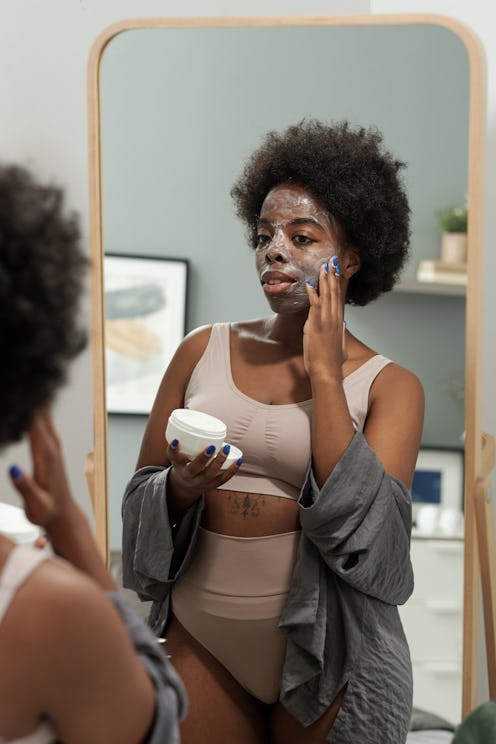Beauty
Peel-Off Face Masks Are The Most Satisfying Way To Exfoliate
Here’s how to find the right one for your skin type.

Few skin care products are as satisfying as peel-off face masks. You know the deal: You smear on the creamy or gel-based concoction, let it dry, and then peel it off for the big glowy reveal (bonus points if you can remove it in one piece). It’s a process, sure, but the best peel-off face masks do more than just buoy your girls’ night group selfies.
Think of peel-off treatments as more purifying, pore-gunk-removing products than sheet and regular face masks. While they have legit skin-boosting benefits, it's really the wow factor of the peeling action that’s won the hearts of beauty lovers and TikTok alike.
Intrigued? Ahead, two board-certified dermatologists break down how peel-off face masks work, which ingredients to look for, and how to wedge the oh-so-pleasing beauty product into your skin care routine.
We at Bustle only include products that have been independently selected by our editors. We may receive a portion of sales if you purchase a product through a link in this article.
How Peel-Off Face Masks Work
Peel-off face masks can address a number of issues, including dull or uneven skin tone and texture, excess oil, and congested pores. “I like to think of peel-off masks as an in-between for chemical and physical exfoliants,” says board-certified dermatologist Dr. Jenny Liu, M.D. These products work by lifting dead skin cells and debris from the outermost layer of your skin through the act of peeling the dried mask off. Compare that to chemical exfoliants, which use alpha- or beta-hydroxy acids to loosen the bonds between skin cells (Though it’s worth noting that many peel-off face masks also contain supporting exfoliating acids.) Traditional physical exfoliants like scrubs, on the other hand, use small, textured particles to remove dead skin cells and debris, board-certified dermatologist Dr. Ryan Turner, M.D. explains.
Though peel-off masks are typically gentler than abrasive scrubs, Turner notes there’s still a risk of injury to the skin. “Peel-off masks can pull excessively on the skin, which can traumatize, irritate, and/or disrupt the skin barrier,” he tells Bustle. Because of this, both derms say that people with especially sensitive skin may want to avoid these products altogether or try a small test spot before using one on the whole face.
Which Ingredients To Look For In A Peel-Off Mask?
As per usual, you’ll want to keep your skin type and concerns in mind when browsing the shelves — some pointers below on which ingredients to look for.
For moisture: Squalane, hyaluronic acid, and glycerin are all great hydrating ingredients that can quench dry complexions.
For exfoliation or breakouts: To keep pores clear and rid them of any buildup, look for exfoliators like salicylic, glycolic, or lactic acid.
For oily skin: Got excesses oil? Reach for beta-hydroxy acids (like salicylic acid) as well as detoxifying kaolin clay or charcoal.
To brighten and address fine lines or wrinkles: Stick with antioxidants like vitamins C and E along with retinol (to stimulate cell turnover).
How To Incorporate A Peel-Off Mask Into Your Skin Care Routine
Your peel-off mask should come with specific instructions, but, generally, you’ll want to apply it to clean skin and let it dry completely before peeling it off (this is usually somewhere between 10 and 20 minutes). The label should also offer recommendations for how often to use the product, but Liu says no more than a few times per week before bedtime is a good rule of thumb.
Shop Peel-Off Face Masks
The Pore Cleanser
Liu points to this peel-off mask as a great choice for congested pores. It uses volcanic clay to help absorb excess sebum along with a blend of glycolic and lactic acids to gently exfoliate and improve the skin’s texture. Smear it on twice weekly for 20 to 30 minutes.
The Drugstore Buy
For an easy, affordable entry into the world of peel-off masks, consider this one that relies on the duo of charcoal powder and salicylic acid to clear the skin. Leave on for 20 minutes or until dry, once or twice per week.
The Hydrator
Both Turner and Liu recommend this peel-off mask for dull, dry skin as it features hydrating hyaluronic acid and soothing algae to deliver intensive moisture. Mix the hyaluronic cushion gel and activating powder to create a bright blue concoction that goes on for five to 15 minutes, once a week.
The Skin Resetter
With red shiso — a plant native to Asia — as its star ingredient, this treatment draws dirt and problem-causing pollutants out of your pores to reveal clearer skin. Smear on once or twice weekly, and let dry for 20 minutes or so.
The Skin Smoother
This exfoliating mask is a favorite of Liu’s for its combo of alpha hydroxy-acid, vitamins A and C, and hyaluronic acid. It works to improve dullness as it sloughs away dead skin buildup without drying your face out. Use once a week, and leave on for 15 to 20 minutes.
The Red Clay Purifier
This peel-off mask relies on red clay to reduce the appearance of pores, control oil production, and attract impurities for a cleaner, healthier complexion. Slather on a thin layer twice weekly, and leave on for 20 minutes for a serious glow.
Experts:
Dr. Jenny Liu, M.D., board-certified dermatologist based in Minneapolis, Minnesota
Dr. Ryan Turner, M.D., NYC-based board-certified dermatologist